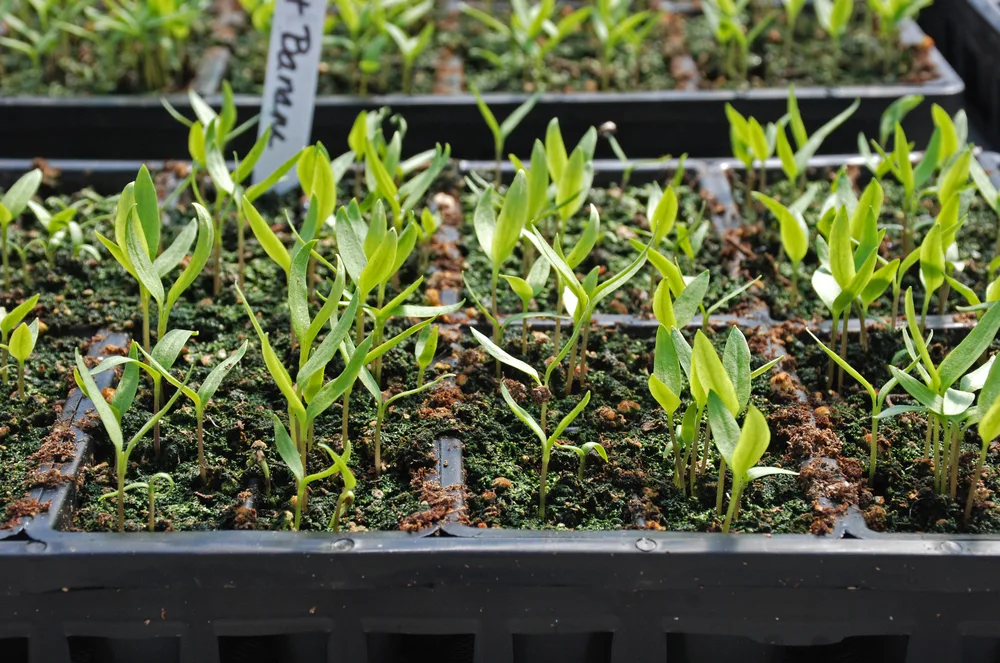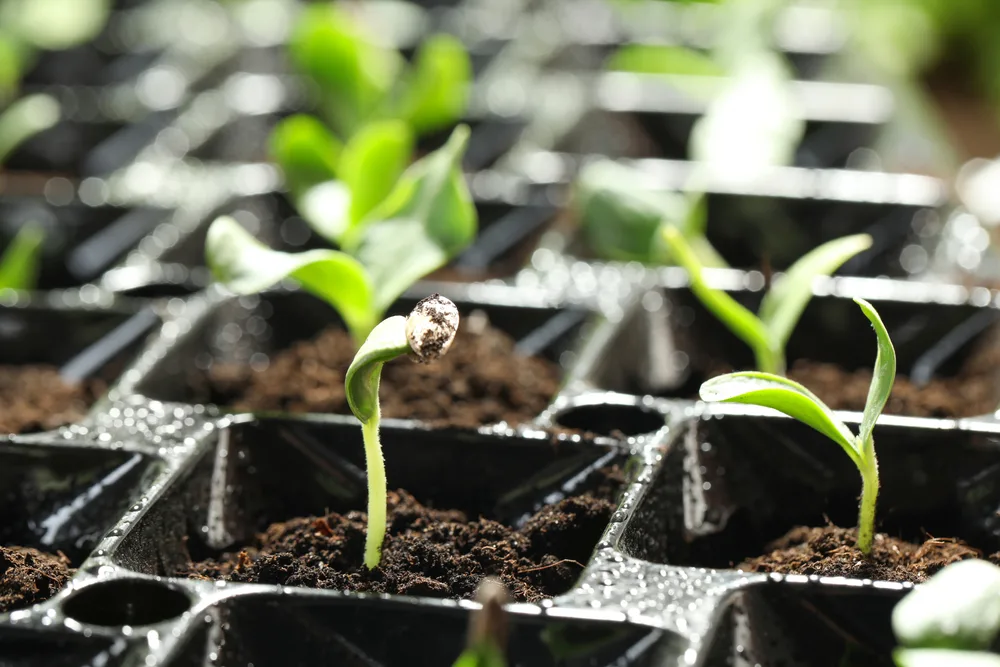
When you reside in climate with a winter solstice, any way you can extend the growing season is an absolute win.
For many, starting seeds indoors will help to jump start gardening operations. By sowing seeds in January, February or March, you will have an array of healthy and more established seedlings to plant in the ground as soon as the soil has warmed in April or May.
Seeds germinate much more quickly when warm. Some seeds, such as parsley and onion, can take 2 to 3 weeks just to sprout. But by keeping the growing medium nice and warm, germination can occur much faster.
Investing in a seedling heating mat is a reliable way to keep those seeds toasty warm when ambient temperatures in your home are still somewhat cool.
What is a Seedling Heat Mat?

Seedling heat mats are made up of multiple layers of high quality, durable, water resistant plastic material with insulated heating coils embedded inside.
When plugged in to a wall outlet, the inner coils heat up to raise the temperature of anything touching the mat to between 10°F to 20°F beyond room temperature.
You can set your seedling trays on top, uncovered, or add a propagation dome to keep soil temperatures more consistent.
Some models heat up to a fixed temperature, set at an optimal range for most types of vegetable seeds, while other models come equipped with a digital temperature controller so you can specify the exact amount of warmth you want.
Outside of the seed starting season, these heat mats are also really useful for keeping your kombucha brew fermenting in the cooler months, speeding up root cuttings, and for chick brooding.
Optimal Germination Temperatures for Vegetables

As you will see, germination temperatures vary widely from one cultivar to the next. Some like it cooler, some like it hot!
| Crop | Minimum Temperature (°F) | Optimal Temperature (°F) | Maximum Temperature (°F) | Days to Germinate in Optimal Temperatures |
| Bean (Lima) | 60 | 85 | 85 | 6 |
| Bean (Snap) | 60 | 80 | 95 | 7 |
| Beets | 40 | 85 | 95 | 4 |
| Broccoli | 40 | 85 | 95 | 4 |
| Brussels Sprouts | 40 | 80 | 95 | 4 |
| Cabbage | 40 | 80 | 100 | 4 |
| Carrot | 40 | 80 | 95 | 6 |
| Cauliflower | 40 | 80 | 100 | 5 |
| Celery | 40 | 70 | 85 | 7 |
| Cucumber | 60 | 95 | 105 | 3 |
| Eggplant | 60 | 85 | 95 | 6 |
| Endive | 35 | 80 | 85 | 6 |
| Kale | 40 | 80 | 95 | 4 |
| Kohlrabi | 40 | 80 | 105 | 4 |
| Leeks | 35 | 70 | 95 | 7 |
| Lettuce | 35 | 75 | 85 | 3 |
| Okra | 60 | 95 | 105 | 6 |
| Onion | 35 | 75 | 95 | 6 |
| Parsley | 40 | 75 | 90 | 13 |
| Parsnip | 35 | 65 | 85 | 14 |
| Peas | 40 | 75 | 85 | 6 |
| Pepper | 60 | 85 | 95 | 8 |
| Pumpkin | 60 | 95 | 100 | 4 |
| Radish | 40 | 85 | 95 | 4 |
| Spinach | 35 | 70 | 85 | 5 |
| Squash | 60 | 95 | 100 | 4 |
| Sweet Corn | 50 | 95 | 105 | 3 |
| Swiss Chard | 40 | 85 | 95 | 4 |
| Tomato | 50 | 85 | 95 | 6 |
| Turnip | 40 | 85 | 105 | 3 |
| Watermelon | 60 | 95 | 105 | 4 |
5 Best Seedling Heat Mats
1. Jump Start Seedling Heat Mat by Hydrofarm
A good introduction into the world of heat mats, the Jump Start is super easy to use – just plug it in and let the mat heat up to its fixed temperature.
The Jump Start is 50% thicker than other heat mats, making it really durable and long lasting. It’s also waterproof, has a 6-foot power cord, and is UL-listed for electrical safety.
It comes in five sizes to meet your propagation needs:
- 3”x 20”
- 6” x 14”
- 9” x 19.5”
- 20” x 20”
- 48” x 20.75”
Purchase the Jump Start Heat Mat here.
2. Heat Mat and Digital Thermostat Combo by iPower
For more control over soil temperatures, iPower’s seedling heat mat comes with a digital thermostat controller that can set temperatures between 40°F and 108°F.
The controller is equipped with a sensor probe that, when poked into a depth of 1” to 1.5” of soil, will provide an accurate read on soil temperatures.
Especially useful when germinating seeds in cooler environments such as a greenhouse or basement, simply raise or lower the temperature as needed.
The iPower heat mat meets MET standards for safety and comes with a one year warranty. It is available in three sizes:
- 10” x 20.5”
- 20” x 20”
- 48” x 20”
Purchase the iPower Heat Mat here.
3. Modular Seedling Heat Mat by Super Sprouter
For a propagation station that grows along with your needs, the Super Sprouter seedling heat mat features a modular design that can add up to 9 more mats, daisy chained together.
Each heat mat is 12” x 48”, which is more than large enough to fit two propagation trays on a single mat.
Durable and easy to use, plug the Super Sprouter heat mat in to warm it up to its fixed temperature.
Purchase Super Sprouter Heat Mat here.
4. Propagation Heat Mat by RHS
A heat mat of a different sort, this product by RHS utilizes film technology that evenly distributes warmth without the need for inner wires.
Made in the USA, this seedling heat mat is flexible and waterproof. It stays flat when in use and rolls up for compact storage.
It’s also available in many sizes, from 11”x 24” to 11” x 120”. Since it comes direct from the manufacturer, you can also order a custom size to suit your needs.
Purchase RHS Heat Mat here.
5. Complete Seedling Germination Kit by HTG Supply
This kit by HTG Supply is replete with all the things required in a setup for propagating and germinating – all you would need are some seeds!
It includes a heat mat, seedling tray with humidity dome, seed plugs, 6400K T5 grow lights, and a light stand.
All together, the assembled size of the propagation station is 26” long, 18.25” wide, and 26.5” tall.
Purchase HTG Supply Germination Kit here.

Get the famous Rural Sprout newsletter delivered to your inbox.
Including Sunday musings from our editor, Tracey, as well as “What’s Up Wednesday” our roundup of what’s in season and new article updates and alerts.

